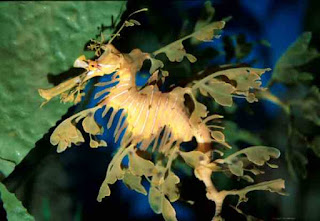Australiana.
Weedy Seadragons (phyllopteryx taeniolatus) lives only in southern Australian waters. The fish are quite large, growing to 46cm. They are redish with yellow spots and blend in with their surroundings. Their red, sandy color does not show against the weedy background as they have green weed-like appendages.
Seadragon males incubate eggs. A female puts about 200 eggs into a brooding pouch on the male during mating. The male fertilizes the eggs in his pouch. The young take two years to become mature.
When seadragons die they are preserved by bony plates. These can be found washed up on beaches. Yearly rings are "recorded" in their ear bones. They live for five years. Seadragons are a barometer for climate change. It the environment deteriorates many die off.
◆ Australiana by Ty Buchanan ◆
●
australian, ocean, phyllopteryx, sea, seadragon, seahorse, south, southern, taeniolatus, waters, weedy




